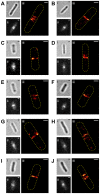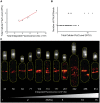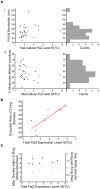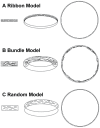In vivo structure of the E. coli FtsZ-ring revealed by photoactivated localization microscopy (PALM)
- PMID: 20856929
- PMCID: PMC2938336
- DOI: 10.1371/journal.pone.0012680
In vivo structure of the E. coli FtsZ-ring revealed by photoactivated localization microscopy (PALM)
Abstract
The FtsZ protein, a tubulin-like GTPase, plays a pivotal role in prokaryotic cell division. In vivo it localizes to the midcell and assembles into a ring-like structure-the Z-ring. The Z-ring serves as an essential scaffold to recruit all other division proteins and generates contractile force for cytokinesis, but its supramolecular structure remains unknown. Electron microscopy (EM) has been unsuccessful in detecting the Z-ring due to the dense cytoplasm of bacterial cells, and conventional fluorescence light microscopy (FLM) has only provided images with limited spatial resolution (200-300 nm) due to the diffraction of light. Hence, given the small sizes of bacteria cells, identifying the in vivo structure of the Z-ring presents a substantial challenge. Here, we used photoactivated localization microscopy (PALM), a single molecule-based super-resolution imaging technique, to characterize the in vivo structure of the Z-ring in E. coli. We achieved a spatial resolution of ∼35 nm and discovered that in addition to the expected ring-like conformation, the Z-ring of E. coli adopts a novel compressed helical conformation with variable helical length and pitch. We measured the thickness of the Z-ring to be ∼110 nm and the packing density of FtsZ molecules inside the Z-ring to be greater than what is expected for a single-layered flat ribbon configuration. Our results strongly suggest that the Z-ring is composed of a loose bundle of FtsZ protofilaments that randomly overlap with each other in both longitudinal and radial directions of the cell. Our results provide significant insight into the spatial organization of the Z-ring and open the door for further investigations of structure-function relationships and cell cycle-dependent regulation of the Z-ring.
Conflict of interest statement
Figures








Similar articles
-
Super-resolution imaging of the bacterial division machinery.J Vis Exp. 2013 Jan 21;(71):50048. doi: 10.3791/50048. J Vis Exp. 2013. PMID: 23380691 Free PMC article.
-
Characterization of the FtsZ C-Terminal Variable (CTV) Region in Z-Ring Assembly and Interaction with the Z-Ring Stabilizer ZapD in E. coli Cytokinesis.PLoS One. 2016 Apr 18;11(4):e0153337. doi: 10.1371/journal.pone.0153337. eCollection 2016. PLoS One. 2016. PMID: 27088231 Free PMC article.
-
Structure of the Z Ring-associated Protein, ZapD, Bound to the C-terminal Domain of the Tubulin-like Protein, FtsZ, Suggests Mechanism of Z Ring Stabilization through FtsZ Cross-linking.J Biol Chem. 2017 Mar 3;292(9):3740-3750. doi: 10.1074/jbc.M116.773192. Epub 2017 Jan 18. J Biol Chem. 2017. PMID: 28100778 Free PMC article.
-
Strong FtsZ is with the force: mechanisms to constrict bacteria.Trends Microbiol. 2010 Aug;18(8):348-56. doi: 10.1016/j.tim.2010.06.001. Epub 2010 Jul 1. Trends Microbiol. 2010. PMID: 20598544 Review.
-
Form and function of the bacterial cytokinetic ring.Curr Opin Cell Biol. 2014 Feb;26:19-27. doi: 10.1016/j.ceb.2013.08.006. Epub 2013 Sep 25. Curr Opin Cell Biol. 2014. PMID: 24529242 Review.
Cited by
-
Three-dimensional super-resolution imaging of the midplane protein FtsZ in live Caulobacter crescentus cells using astigmatism.Chemphyschem. 2012 Mar;13(4):1007-12. doi: 10.1002/cphc.201100686. Epub 2012 Jan 20. Chemphyschem. 2012. PMID: 22262316 Free PMC article.
-
Bacterial actin and tubulin homologs in cell growth and division.Curr Biol. 2015 Mar 16;25(6):R243-R254. doi: 10.1016/j.cub.2015.01.030. Curr Biol. 2015. PMID: 25784047 Free PMC article. Review.
-
Subdiffractive microscopy: techniques, applications, and challenges.Wiley Interdiscip Rev Syst Biol Med. 2014 Mar-Apr;6(2):151-68. doi: 10.1002/wsbm.1259. Epub 2014 Jan 17. Wiley Interdiscip Rev Syst Biol Med. 2014. PMID: 24443323 Free PMC article. Review.
-
MinCDE exploits the dynamic nature of FtsZ filaments for its spatial regulation.Proc Natl Acad Sci U S A. 2014 Apr 1;111(13):E1192-200. doi: 10.1073/pnas.1317764111. Epub 2014 Mar 18. Proc Natl Acad Sci U S A. 2014. PMID: 24707052 Free PMC article.
-
An intrinsically disordered linker plays a critical role in bacterial cell division.Semin Cell Dev Biol. 2015 Jan;37:3-10. doi: 10.1016/j.semcdb.2014.09.017. Epub 2014 Oct 13. Semin Cell Dev Biol. 2015. PMID: 25305578 Free PMC article. Review.
References
-
- de Boer P, Crossley R, Rothfield L. The essential bacterial cell-division protein FtsZ is a GTPase. Nature. 1992;359:254–256. - PubMed
-
- Lowe J, Amos LA. Crystal structure of the bacterial cell-division protein FtsZ. Nature. 1998;391:203–206. - PubMed
-
- RayChaudhuri D, Park JT. Escherichia coli cell-division gene ftsZ encodes a novel GTP-binding protein. Nature. 1992;359:251–254. - PubMed
Publication types
MeSH terms
Substances
Grants and funding
LinkOut - more resources
Full Text Sources
Other Literature Sources
Research Materials

